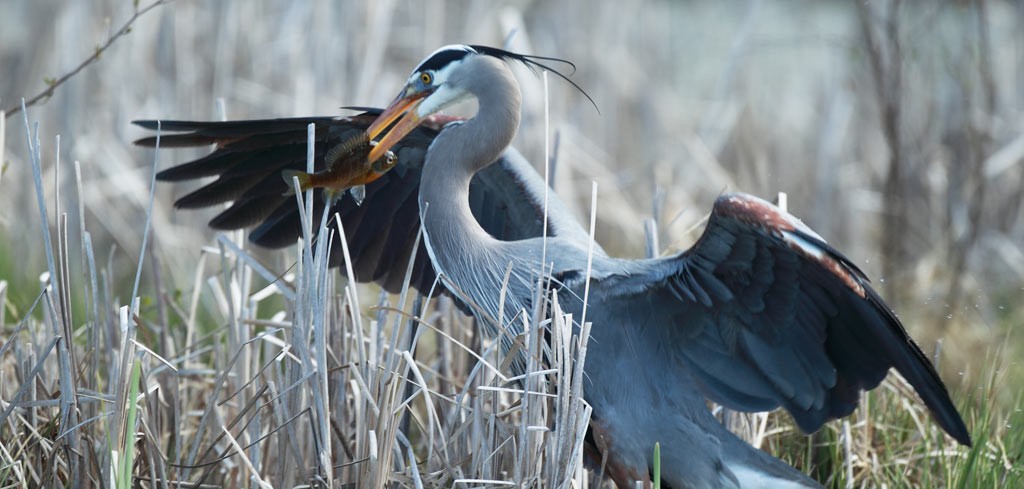Piscivorous Predators
From the Summer 2015 Issue
Steve Jamsa

Many of the best fish stories don’t involve humans at all.
The furry and feathered fishermen
When you live around lakes where fish are part of the culture, chances are you’ve heard your share of fish stories. I thought I’d heard them all – tales of fighters that snapped lines, accounts of fish that surely would have broken records if hooked, and even conspiracy theories of sturgeonesque lake creatures.
But the best fish story I’ve heard in a while came from Ed Dickson, long-time captain of Diamond Charters on Lake Pend Oreille. He told of an otherwise ordinary day catching 30-some-inch trout with two clients, when he heard a line whir, followed immediately by another rod bending. As he helped the fishermen with their lines, he heard a third reel go off but couldn’t spot the line anywhere in the water. Squinting in the sun, he finally traced it – heading straight into the air, pulled taut in an eagle’s clutch.
Turns out, many of the best fish stories don’t involve humans at all.
Barbara and Dave Gillespie, board members of Lake Pend Oreille Idaho Club, confirmed this when they relayed a story of witnessing an osprey with “eyes too big for its belly and body”: After diving to snag a rainbow released from a derby contestant, the osprey – overwhelmed by the fish’s size – had to do a sort of splatter-flutter breast stroke 300 yards to shore. The Gillespies watched as the bedraggled and exhausted osprey finally dragged the fish onto a rock, stood atop it, and reaped the rewards. All in all, a happy ending.
Ospreys are surely the greatest hooks in fish flesh here. They feed almost wholly on live fish, and unlike some of us – they actually catch fish. According to Cornell Lab of Ornithology, ospreys’ success rate is estimated between 70 and 90 percent, with an average of only 12 minutes spent hunting from perch or midair.
From as high as 120 feet, ospreys will dive, feet first, and often completely submerge, aided by uniquely dislocatable shoulder joints, underwater vision and closing nostrils. Fish have little chance of escape from the tight grip of spiny-spiked talons. Ospreys then rotate their prey face forward for streamlined flight back to the nest. Brilliant adaptation is a theme that runs through fish stories.
Though eagles are perhaps slightly less sporting than ospreys, their fishing know-how is not to be diminished. They will perch on shoreline snags contentedly for hours, and then suddenly arrow across a bay, plunging and lifting again with a writhing tail. With their ability to see fish from several hundred feet away – some purport as far as two miles even – and with a diving speed between 125 and 200 miles an hour, they are taloned clippers.
They aren’t above shortcuts though: Rather than always fishing for themselves, they have no trouble pilfering from others, whether catch dropped from another raptor, stolen directly from their talons, or snagged off Captain Ed’s boat. I once watched a bald eagle patiently wait over open water in an otherwise frozen bay until a raven began circling overhead. When the eagle flew up to dissuade the raven, a fish left the cover of ice and another eagle swooped down to lift dinner. A fable to heed, indeed.
Also in this fish story hall of fame are herons – keepers of bays, inlets and estuaries. They wade in measured meditation like agile fly fishermen casting sidelong glances for movement beneath the surface. Statuesque, stealth and often in solitary stoicism, they stalk and strike with whip-sharp accuracy, and then shake impaled fish to relax their sharp spines before swallowing them whole. They are clearly suited to fish, too, with long wading legs, dagger-like bills and chest feathers called “powder down” that they use to remove fish slime and oils after successful catches. Talk about resolution.
If herons are the bay watch, kingfishers are the royal guards. With an apropos name, these regal sentries who eat mostly small fish often mount atop power lines, snags, or other perches in sit-and-wait predation, or patrol tributaries and shorelines. Unlike herons that shake their prey, kingfishers billy club them against their perch before swallowing them whole.
A whole cast of other piscivorous characters also take advantage of the lake’s offerings. Grebes, loons, mergansers and various waterfowl chase schools of baitfish. Caspian terns were among the most abundant fish-eating waterbirds counted in 2014 Clark Fork Delta Restoration surveys. Cormorants have been frequenting the flyway. And as the Gillespies related, seagulls commonly engage anglers in unwelcomed tugs-of-war.
This narrative would be incomplete, though, without mentioning the more covert piscivorous mammals, such as river otters that eat slow-moving, mid-size fish; or raccoons – like opportunistic dogs awaiting scraps from above – that glean eagles’ and ospreys’ dropped fish. During the fall kokanee spawn, bear populations around tributaries swell as they attempt to fill bellies for hibernation. A biologist friend described the benefits of this give-and-take: Think fish meal fertilizer scat scattered about.
Idaho Fish and Game Regional Fishery Manager Jim Fredericks also stressed these connections. He emphasized how maintaining a fishery of native species – with bull trout, cutthroat and kokanee running up tributaries to spawn – also sustains bears, coyotes, mink and others, as opposed to a fishery of deepwater species that are virtually unavailable to predators.
Fish have been protagonists in legends of survival since before the first peoples told them around fires, and continue today. We all share these singular waters in an epic scene stocked with tales that involve the feathered, furred and adrenaline-fueled. Our task is to ensure continuance of them all.




Leave a Reply